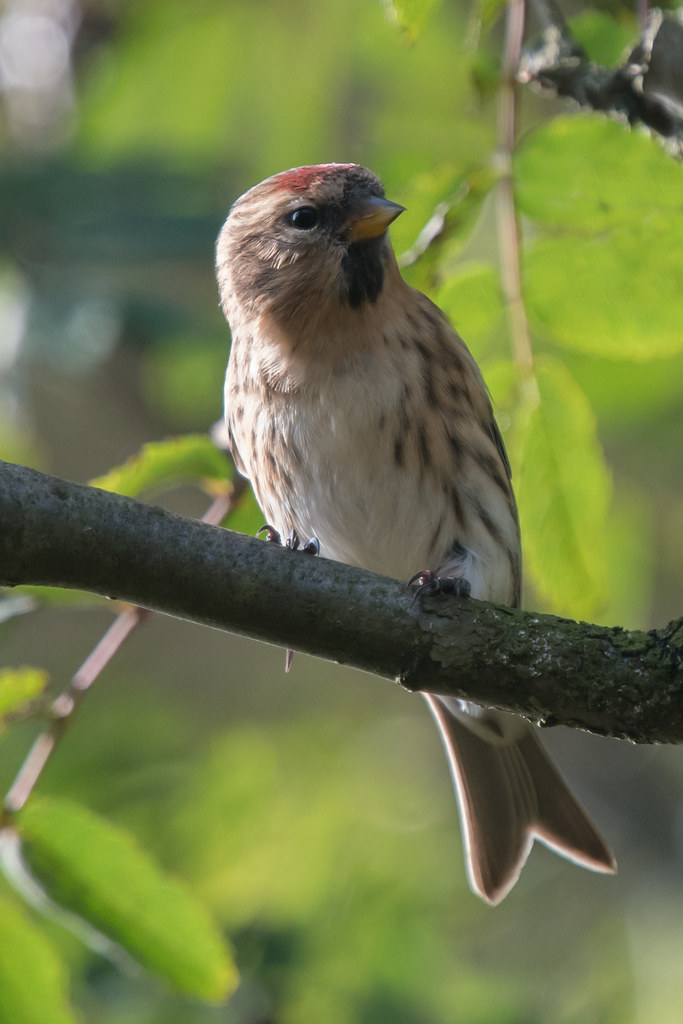
Tim writes: some books and websites call this species Lesser Redpoll (Acanthis cabaret) but there is no genetic difference between these and Common Redpolls (A. flammae). And from 1 January 2018 BOU officially dropped this species to become a subspecies of Common Redpoll when they adopted the IOC species guidelines.
So this is now Common Redpoll (Acanthis flammae subsp cabaret). But oddly Lesser Redpoll is still on the BOU Official List nearly three years later. Lesser Redpoll’s status as a species was only short-lived as BOU only accepted it as a species in 2001 on the basis of a small population in Norway in 1994 that held 6 pairs of cabaret and 5 pairs of flammae, with no evidence of mixed pairs.
The name Redpoll refers to the red on the head, as poll originally meant head. The red on the forehead is just visible here, as is the distinctive black moustache. The meaning of poll as a vote came about, as a poll was originally a head count. It now rarely survives in its original meaning although the bit between the ears on a horse or cow is called a poll, and a poll axe wasn’t used for chopping trees.
They are much smaller than most people realise. For comparison a House Sparrow weighs 34g whereas this chap weighs just 11g. This was taken in the Peak District in September.
[registration_form]
I believe that, in cattle, ‘poll’ also means hornless. The Red Poll cattle breed is naturally hornless and red all over (not just on the head).
A lovely photo – as usual.
and in horses “poll” is the (sensitive) bit of the top of the head between the ears
Years ago in northern Sweden ringing Redpolls, although all three that we caught were treated in ringing records as separate:- Brun Siska (lesser), Gra Siska ( common) and Snosiska ( Coues Arctic) the locals said they were all the same just different breeding populations, there are now lots of Lesser Redpolls in Scandinavia-Climate change?
Sorry Tim – accidental dislike recorded
An interesting comment, Paul. In 1974 I was involved in ringing a large number of Redpoll on Varangerfjord in arctic Norway. There was a wide range from ‘standard’ Redpoll to very clear ‘Arctic’ BUT in the hand there was no ‘breakpoint’ in plumage. the plumages felt like a cline, not speciation, as reflected in your comment. I’ve always felt that the need to tick a ‘species’ affects the birders view of this sort of thing – in botany hybrids/varieties etc are more recognised – though the species/ subspecies, lumper/splitter arguments seem to be common across the spectrum.
Now, I must get back to my Birdwatchers Yearbook and see if I can make head or tail of the geneticists latest re-organisation of the species list.
For information over a number of visits 1994-2018 the Redpoll totals we caught on Stora Fjäderägg in the Holmon islands were
Lesser Redpoll 169
Common Redpoll 3719
Coue’s Arctic Redpoll 21
Quite so.
With respect this post appears to be inaccurate. See https://twitter.com/NTBirdClub/status/1356999648133709828
We’ve had an influx of them lately so I’ve been trying to clarify which version they are.